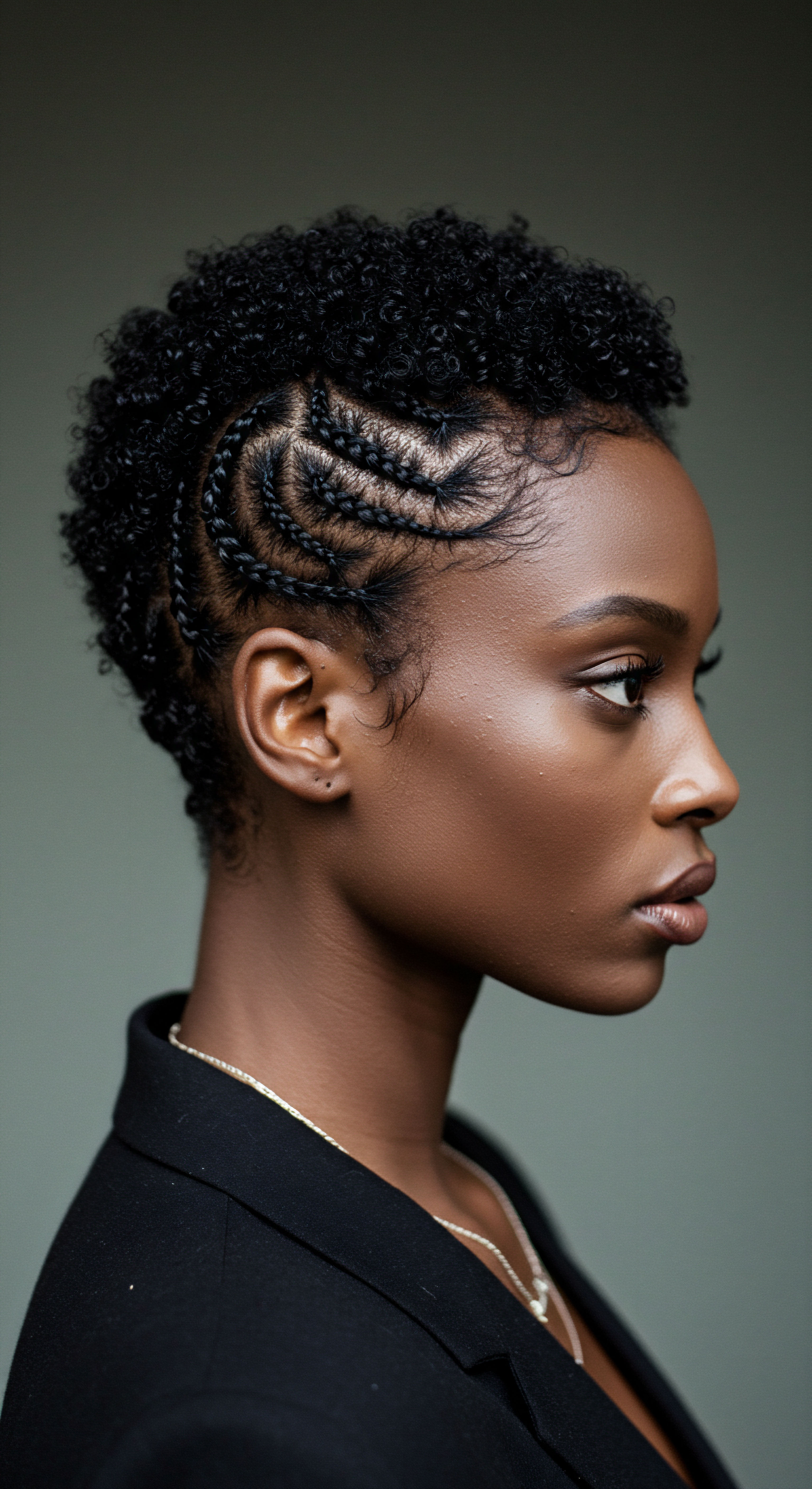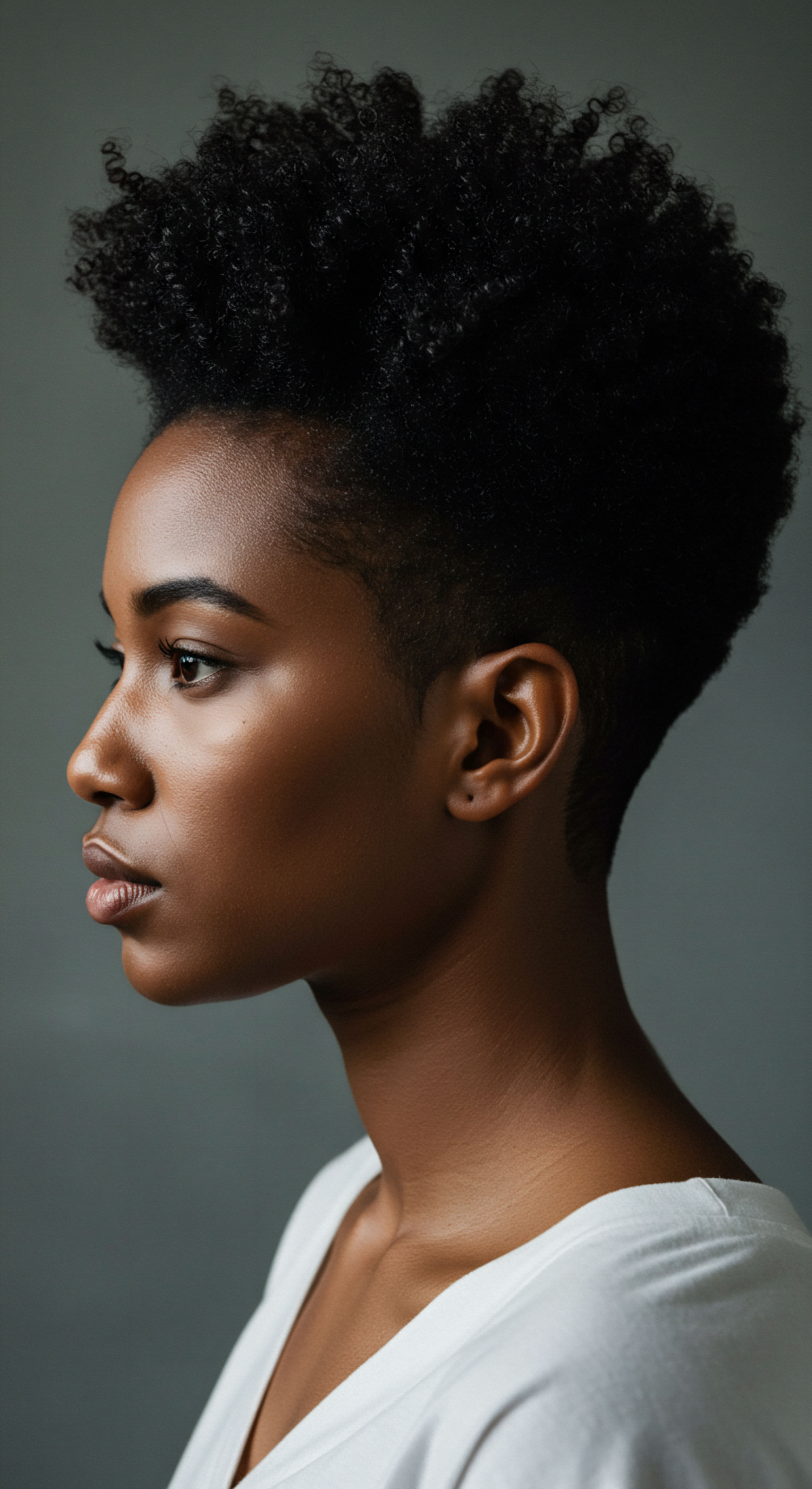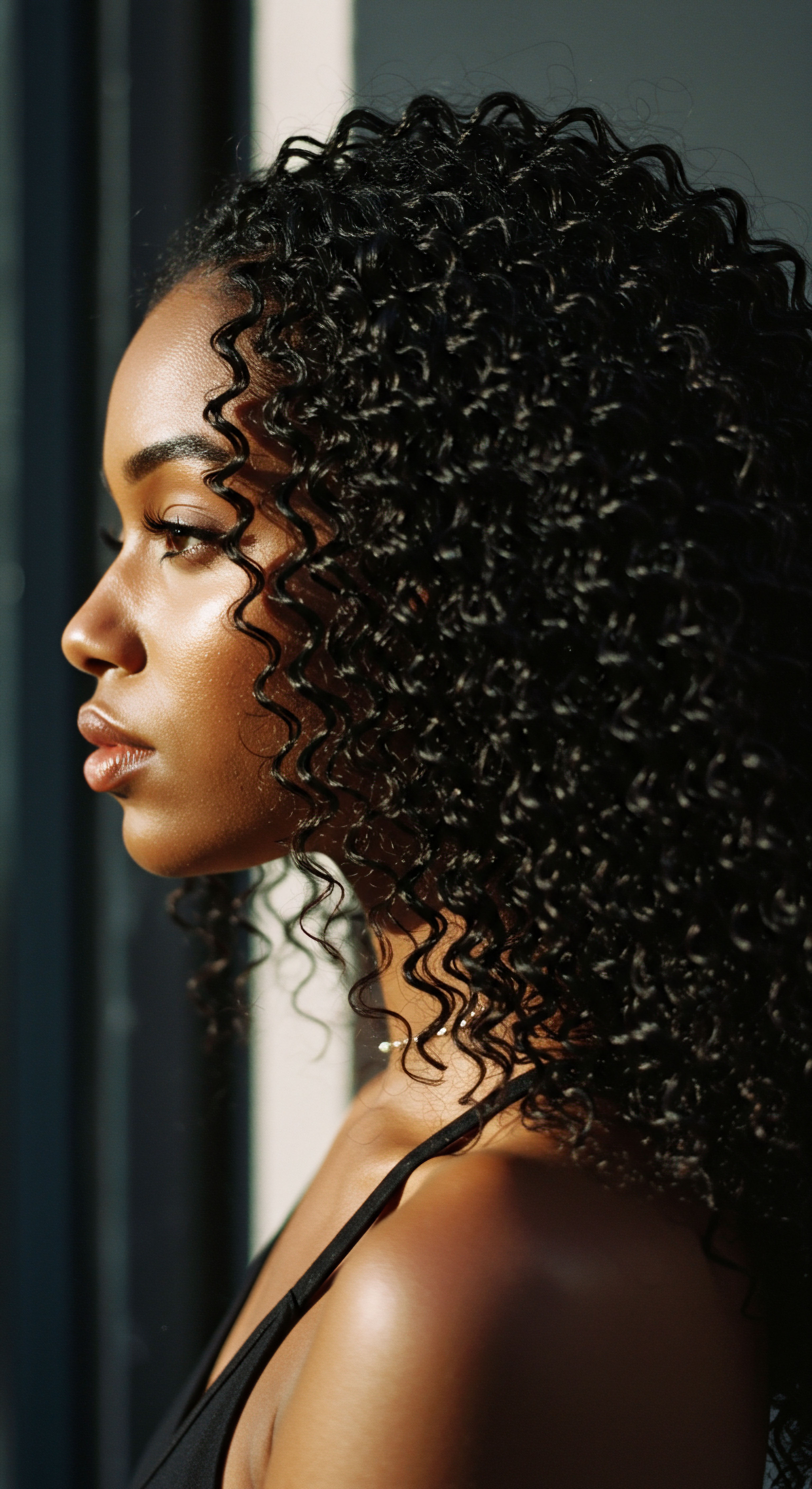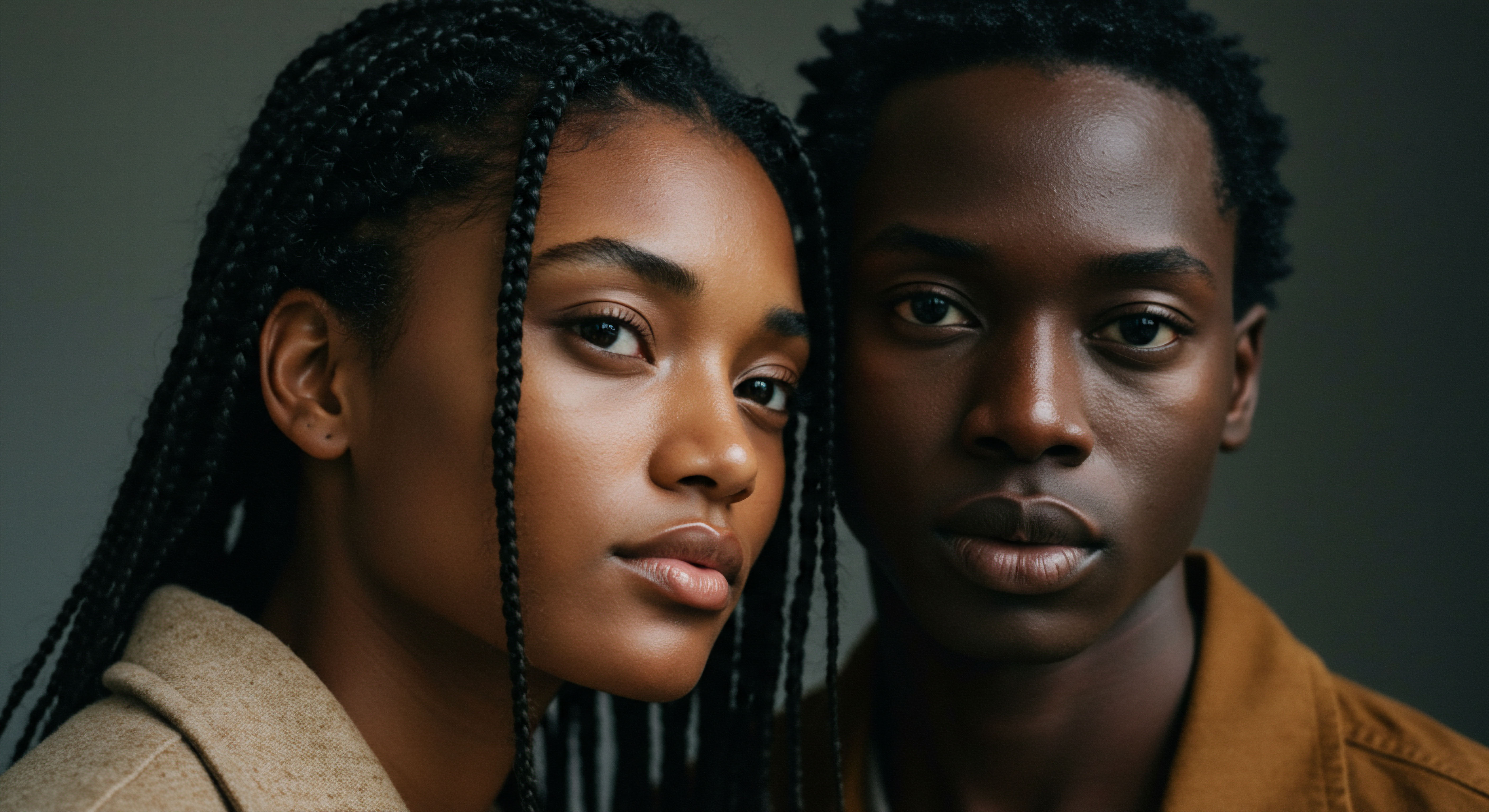
Roots
A quiet question often arises as twilight descends and the world prepares for slumber ❉ how does one preserve the tender, intricate nature of textured hair through the long hours of night? It is a curiosity born of daily experience, a silent yearning for strands that greet the dawn with the same vitality they held at dusk. This inquiry reaches beyond simple care; it speaks to a deeper connection with our hair, a recognition of its inherent vulnerability and profound resilience. To truly grasp the bonnet’s role in this nightly preservation, we must first descend into the very essence of textured hair itself, understanding its architecture and its particular relationship with the elements that surround it.
The journey begins at the microscopic level, where the very structure of textured hair unveils its unique characteristics. Unlike straight strands, which present a relatively smooth, uniform surface, each textured hair fiber exhibits a distinct elliptical or even flat cross-section. This unique shape dictates the hair’s natural curl pattern, ranging from gentle waves to tightly coiled spirals. The curvature of the hair shaft means that the cuticle, the outermost protective layer composed of overlapping scales, does not lie as flat as it might on straight hair.
Instead, these scales tend to be slightly raised, particularly at the curves and bends of the strand. This inherent structural quality, while contributing to the hair’s magnificent visual depth and volume, also presents a particular challenge concerning moisture retention.
Consider the cuticle as a delicate shield. When its scales are raised, even slightly, the inner cortex of the hair becomes more exposed to the environment. This openness allows moisture, the lifeblood of healthy hair, to escape more readily into the surrounding air.
Conversely, it also means that the hair can absorb moisture from the atmosphere, leading to swelling and the familiar phenomenon of frizz. The delicate balance between moisture absorption and loss is a constant dance for textured hair, a dance heavily influenced by humidity, temperature, and crucially, the physical interactions it experiences throughout the day and night.
The distinct elliptical cross-section and raised cuticle scales of textured hair render it inherently susceptible to moisture depletion.

Hair Fiber Architecture and Moisture Dynamics
The precise arrangement of keratin proteins within the hair shaft further influences its moisture dynamics. Textured hair often possesses fewer disulfide bonds compared to straight hair, and these bonds are distributed differently, contributing to its spring and elasticity. However, this also means that the hair can be more fragile and prone to breakage if not properly cared for.
The lipid layer, a thin coating of natural oils that covers the cuticle, serves as another vital component in moisture regulation. When this layer is compromised, whether through harsh cleansing, mechanical friction, or environmental exposure, the hair’s ability to hold onto its internal water content diminishes significantly.
Understanding these foundational elements of textured hair anatomy is paramount. It establishes the context for why protective measures, particularly during sleep, move from mere convenience to a fundamental act of care. The nightly hours, often overlooked, represent a prolonged period of potential interaction with environmental factors and physical stressors. Without intervention, the hair’s inherent structure, with its slightly lifted cuticles and often compromised lipid layer, can lead to substantial moisture depletion, resulting in dryness, brittleness, and ultimately, breakage.

Why Does Textured Hair Crave Moisture?
The thirst of textured hair for moisture is not merely a preference; it is a physiological requirement rooted in its very composition and form. The helical structure of coils and curls creates numerous points of contact between individual strands, increasing the surface area exposed to the air. This increased exposure facilitates faster evaporation of water from the hair shaft.
Moreover, the natural sebum produced by the scalp, which serves as a natural conditioner and protectant, struggles to travel down the curved and coiled strands as effectively as it does on straight hair. This often leaves the mid-lengths and ends of textured hair particularly vulnerable to dryness, necessitating external hydration and diligent moisture retention strategies.
- Cuticle orientation ❉ The slightly lifted scales of textured hair cuticles allow for easier moisture escape.
- Hair Shaft shape ❉ The elliptical or flat cross-section of textured hair leads to more exposed surface area for evaporation.
- Sebum distribution ❉ Natural scalp oils struggle to coat the entire length of coiled strands, leaving ends drier.

Ritual
As the day concludes and the body seeks repose, a familiar ritual unfolds for many with textured hair ❉ the donning of a bonnet. This act, seemingly simple, transcends mere habit, becoming a deliberate gesture of preservation, a silent pact with the strands that have navigated the day’s demands. It is a moment of gentle preparation, a recognition that the night holds both the promise of rest and the potential for unintended harm to our delicate coils and curls. The bonnet, then, steps onto the stage not as a mere accessory, but as a guardian, an integral part of a nightly care practice designed to shield and sustain.
The core purpose of the bonnet, in its various forms, centers on creating a micro-environment for the hair. During sleep, our movements, however slight, inevitably bring our hair into contact with bedding materials. Traditional pillowcases, often made of cotton, possess a thirsty, abrasive surface. The microscopic fibers of cotton, while soft to human skin, are surprisingly rough against the delicate cuticle layer of hair.
Each turn of the head, each shift in position, generates friction. This friction acts like a gentle sandpaper, abrading the cuticle, lifting its scales further, and inadvertently stripping away precious moisture and the hair’s natural lipid layer.
A bonnet, typically crafted from smooth, low-friction materials such as satin or silk, acts as a protective barrier. By encasing the hair within its soft confines, it prevents direct contact with the cotton pillowcase. This immediate reduction in mechanical friction is the bonnet’s primary defense mechanism. With less friction, the cuticle scales remain flatter, preserving the hair’s natural smoothness and significantly minimizing moisture loss through evaporation from an exposed, roughened surface.
Bonnets, through their smooth fabric, construct a protective micro-environment that significantly mitigates moisture loss by reducing hair-to-pillow friction.

The Fabric of Protection
The choice of material for a bonnet is not a trivial matter; it is fundamental to its efficacy. Satin and silk are favored for their exceptionally smooth surfaces. Unlike cotton, which has a complex, absorbent fiber structure, satin and silk fibers are long, smooth, and tightly woven.
This creates a surface with very little drag, allowing hair to glide effortlessly against it. This glide translates directly into reduced mechanical stress on the hair shaft.
Consider the distinct properties ❉
- Satin ❉ Often made from synthetic fibers like polyester, satin is a weave that creates a glossy, smooth surface. It is highly effective at reducing friction and is a more accessible option. Its smoothness helps to keep the hair’s cuticle layer undisturbed.
- Silk ❉ A natural protein fiber, silk possesses an even smoother surface than satin and is inherently less absorbent. Its protein structure is remarkably similar to that of human hair, making it particularly gentle. Silk also has temperature-regulating properties, helping to maintain a comfortable environment for the scalp.
Beyond preventing friction, these materials also play a role in maintaining the hair’s moisture balance. While cotton actively wicks moisture away from the hair due to its absorbent nature, satin and silk are far less absorbent. They allow the hair’s natural oils and any applied conditioning treatments to remain on the hair strand, rather than being drawn into the fabric. This preservation of both internal hydration and external emollients is a critical aspect of overnight moisture maintenance.

Maintaining Hair’s Hydration Overnight
The nightly application of leave-in conditioners, oils, or creams becomes significantly more impactful when followed by bonnet use. These products, designed to provide and seal moisture, have a far greater chance of remaining on the hair and being absorbed throughout the night when protected from environmental exposure and abrasive surfaces. The bonnet essentially acts as a gentle, breathable seal, creating a humid microclimate around the hair. This slightly elevated humidity within the bonnet discourages the rapid evaporation of water from the hair shaft, allowing the hair to remain supple and hydrated.
For those with particularly dry or high-porosity hair, the difference a bonnet makes can be profound. High-porosity hair, with its more open cuticle, is quick to absorb moisture but equally quick to release it. A bonnet provides the necessary containment to slow this release, giving the hair more time to benefit from applied products and reducing the overall moisture deficit experienced overnight.
| Fabric Type Cotton |
| Surface Texture Rough, fibrous |
| Moisture Absorbency High |
| Friction Level High |
| Impact on Hair Wicks moisture, causes frizz, breakage |
| Fabric Type Satin |
| Surface Texture Smooth, synthetic |
| Moisture Absorbency Low |
| Friction Level Low |
| Impact on Hair Preserves moisture, reduces friction |
| Fabric Type Silk |
| Surface Texture Very smooth, natural protein |
| Moisture Absorbency Very Low |
| Friction Level Very Low |
| Impact on Hair Optimal moisture preservation, minimal friction, gentle |
| Fabric Type Smooth, non-absorbent fabrics are superior for overnight hair protection. |

Relay
How does the bonnet’s subtle presence during our slumber translate into such a profound difference for textured hair? The answer resides in a confluence of biophysical principles, historical echoes, and a deep understanding of hair’s delicate ecosystem. Beyond the immediate physical barrier, the bonnet participates in a complex interplay of forces that collectively preserve moisture and promote hair health. This deeper examination moves us beyond simple observation, inviting us to consider the nuanced mechanisms at play.
At its heart, the bonnet’s effectiveness is grounded in the principles of atmospheric science, albeit on a micro-scale. Our hair, like all organic matter, is constantly exchanging moisture with its surrounding environment. When the ambient air is drier than the hair, water molecules naturally migrate from the hair shaft into the air, a process known as evaporation. Cotton pillowcases exacerbate this by presenting a large, dry surface area that readily absorbs moisture, creating a strong vapor pressure gradient that pulls water from the hair.
The bonnet disrupts this gradient. By enclosing the hair within a relatively small, contained space, it allows the humidity within that space to increase. As the air inside the bonnet becomes more saturated with moisture, the rate of evaporation from the hair significantly slows, effectively “trapping” the hydration where it belongs.
A study published in the Journal of Cosmetic Science in 2008, while not directly on bonnets, explored the effects of relative humidity on hair fiber properties, demonstrating that hair exposed to lower humidity experienced greater moisture loss and became more prone to mechanical damage. This research underscores the importance of maintaining a humid microclimate around the hair, a condition precisely what a bonnet facilitates. The bonnet creates a localized zone of higher relative humidity, counteracting the drying effects of a typical bedroom environment, especially those with air conditioning or heating that can drastically lower ambient moisture levels.
The bonnet creates a localized zone of higher relative humidity around the hair, significantly reducing moisture evaporation.

Microclimate Control and Hair Resilience
The regulation of this microclimate extends beyond simple evaporation control. It also influences the hair’s viscoelastic properties. Hair, a protein fiber, exhibits both elastic (ability to return to original shape) and viscous (resistance to flow) characteristics. When adequately hydrated, hair is more elastic and pliable, making it less susceptible to mechanical damage.
Dry hair, conversely, becomes stiff and brittle, increasing its likelihood of breakage during tossing and turning. By maintaining optimal hydration, the bonnet contributes to the hair’s overall resilience, making it more robust against the stresses of sleep.
Beyond the scientific mechanics, the bonnet carries a rich cultural weight, particularly within Black communities. Its usage extends back generations, predating modern cosmetic science, rooted in practices of hair preservation passed down through families. These traditions, born of lived experience and observation, intuitively understood the need to protect textured hair from environmental aggressors and maintain its integrity. The bonnet, therefore, is not merely a tool; it is a continuation of ancestral wisdom, a tangible link to practices that recognized and celebrated the unique requirements of Black hair.

Cultural Significance and Continuity
The cultural significance of head coverings, including bonnets, in African and diasporic traditions speaks to a deep respect for hair as a symbol of identity, beauty, and status. Historically, hair was often elaborately styled and meticulously cared for, and its protection, especially during rest, was paramount. This cultural continuity provides a powerful, often unspoken, affirmation of the bonnet’s role. It is a testament to collective knowledge, a practical solution refined over centuries that aligns seamlessly with contemporary scientific understanding of hair physiology.
The bonnet also plays a critical role in preserving hairstyles. For many with textured hair, styling can be a time-consuming and intricate process. By protecting the hair from friction and frizz, the bonnet extends the life of braids, twists, wash-and-gos, and other styles.
This preservation reduces the need for frequent re-styling, which in turn minimizes manipulation and heat exposure, both of which can contribute to dryness and damage over time. Less manipulation means less stress on the hair shaft, allowing it to retain its natural moisture and strength.
| Mechanism Friction Reduction |
| Description Smooth fabric prevents abrasion against pillowcases. |
| Direct Impact on Moisture Minimizes cuticle damage, preventing moisture escape. |
| Mechanism Microclimate Creation |
| Description Encloses hair, raising localized humidity. |
| Direct Impact on Moisture Slows evaporation of water from hair shaft. |
| Mechanism Product Preservation |
| Description Keeps applied oils and conditioners on hair. |
| Direct Impact on Moisture Ensures active ingredients remain to hydrate and seal. |
| Mechanism Style Preservation |
| Description Maintains integrity of overnight styles. |
| Direct Impact on Moisture Reduces need for restyling, limiting manipulation and stress. |
| Mechanism Thermal Regulation |
| Description Some materials (silk) help maintain stable hair temperature. |
| Direct Impact on Moisture Prevents excessive drying from heat fluctuations. |
| Mechanism The bonnet's protective benefits extend across physical, environmental, and practical dimensions. |

Beyond the Physical ❉ A Holistic View
The regular use of a bonnet fosters a virtuous cycle for hair health. Consistent moisture retention leads to stronger, more elastic strands that are less prone to breakage. This reduced breakage allows hair to retain length and density, contributing to overall hair vitality. The psychological benefit of waking with well-preserved hair also merits consideration.
The confidence and ease that come from a good hair day, directly influenced by effective nighttime care, can positively impact one’s morning routine and self-perception. It transforms a potential struggle into a moment of gentle affirmation.
The collective wisdom of generations, combined with the clear scientific rationale, positions the bonnet as a simple yet profoundly effective tool in the holistic care of textured hair. Its ability to create a controlled, protective environment against the drying and damaging forces of friction and evaporation makes it an indispensable component of a regimen aimed at nurturing healthy, hydrated, and vibrant strands. The relay of this knowledge, from ancestral practice to scientific validation, confirms its enduring value.

Reflection
As the morning light filters through, touching upon coils and curls that have rested undisturbed, a quiet understanding settles. The bonnet, in its unassuming form, has orchestrated a silent symphony of preservation through the night. It has stood as a gentle sentinel, shielding our hair from the abrasive whispers of fabric and the subtle draw of the air.
This nightly act, woven into the fabric of daily life for so many, speaks to a deeper connection with our strands, a recognition of their unique spirit and their enduring need for tender care. It is a practice that bridges the wisdom of the past with the insights of the present, allowing textured hair to awaken refreshed, hydrated, and ready to meet the day with its inherent splendor.

References
- Robbins, C. R. (2008). Chemical and Physical Behavior of Human Hair. Springer Science & Business Media.
- Dawber, R. P. R. (2002). Diseases of the Hair and Scalp. Blackwell Science.
- Bhushan, B. (2010). Handbook of Nanotechnology. Springer. (Contains sections on surface properties and friction of materials, applicable to hair-fabric interaction).
- Johnson, B. A. (2014). The Science of Black Hair ❉ A Comprehensive Guide to Textured Hair Care. The Hair Architect.
- Khumalo, N. P. & Ngwanya, R. M. (2007). Hair and Scalp Diseases ❉ A Practical Guide. Informa Healthcare.
- Wickett, R. R. & Mills, O. H. (2009). Practical Hair Science. Allured Business Media.
- Gavazzoni Dias, M. F. (2015). Hair cosmetics ❉ An overview. International Journal of Trichology, 7(1), 2-15.
- Van Neste, D. (2002). Hair and Hair Diseases. Marcel Dekker.
- Wolfram, L. J. & Wortmann, F. J. (2003). The Science of Hair Care. Marcel Dekker.